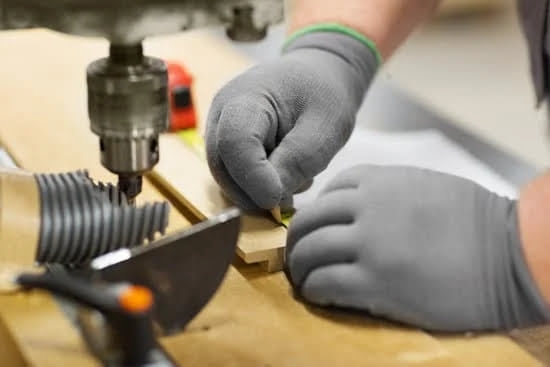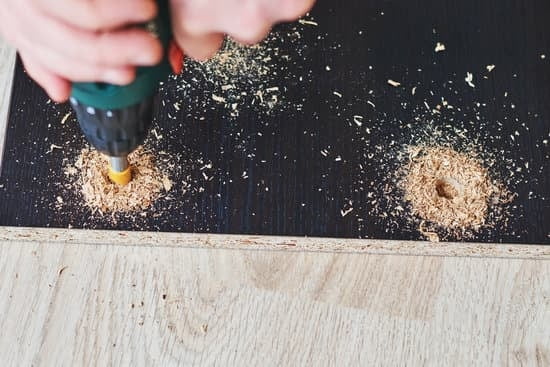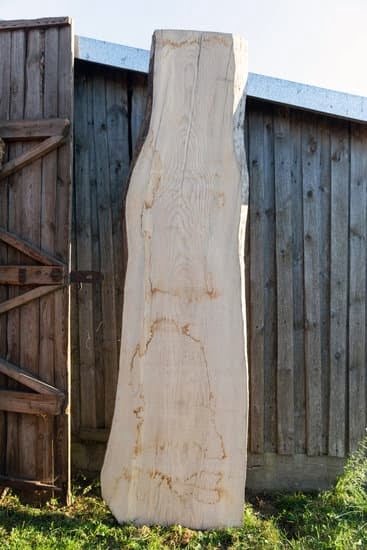Introduction to Woodworking Saw Types
1. Hand Saws – Hand saws are the most basic type of saw and are used primarily for rough cutting. They usually have a long, thin handle called a “tang” and either a single or double-handle grip that you hold onto in order to provide leverage as you push and pull the saw through the wood. The primary types of hand saws are crosscut saws, which cut across the grain of wood, rip saws, which cut with the grain, tenon saws, which have finer blades used for making accurate cuts while joining two pieces of wood together, dozuki saws made specifically for delicate joinery work and keyhole saws used mainly for cutting small holes in wood and metal.
2. Power Saws – Power saws automate the process of cutting through wood quickly and precisely. The most commonly used power saw is the circular saw; it has a spinning blade that can move up and down or slightly tilt to cut angles as desired. A jigsaw or sabre saw is also frequently used to make curved cuts or notch corners at an angle. Band or scroll saws use thin blades stretched between two wheels to make intricate curves available with precision rip-fences for straight cuts. Compound miter or chop saws useful for making angled cuts employed when constructing cabinetry frames, stairs etc by setting exact angles that remain consistent over multiple cuts
3. Coping Saws – Coping Saw is deemed indispensable among molding craftsman due its ability to create exceptionally fine designs on wood thanks to small blade tensioned at both sides giving excellent control over curves although they struggle with thicker materials while coping bandsaws helps combat this problem
4 Router Bits – Router bits are unique tool bits that allow carpenters create varied profiles on edges & surfaces of woods due according flexibility needed when working with components such shapes normally produced using table-mounted routers wherein router bit rotates at high speeds though motion generated by user
Hand Saws Types, Advantages, Disadvantages and Uses
Hand saws are a type of saw that is operated manually by the user. They consist of a metal blade with regularly spaced teeth along one edge, which are used for cutting through thicker materials such as wood and metal. Hand saws can be purchased in a variety of sizes, depending on the size of material that needs to be cut.
Types: The different types of hand saws include ripping saws, crosscut saws, coping tools, back saws, miter box saws and hacksaws.
Advantages: The main advantage of using hand saws is that they provide flexibility since they can be adapted to various cutting tasks. This is because they offer control and accuracy when cutting angles or shapes. In addition, they reduce fatigue since they have handles which help to lessen stress on your hands while working.
Disadvantages: One disadvantage is that hand saws require more effort from the user than power-driven saws due to having to manually move the blade up and down. Another disadvantage is that hand saw blades are relatively short meaning prolonged use can lead to fatigue in the wrist and forearm muscles as well as resulting in inaccuracy if one does not take frequent breaks during usage.
Uses: Hand saws are mainly used for detailed precision cutting where accuracy is important in carpentry work and DIY projects such as making furniture or molding. They are also suitable for rough cutting applications such as ripping boards apart or constructing boxes out of wood planks. Additionally, they can be used to make cuts along pre-existing lines safely without damaging surrounding material when other power tools may do this unintentionally
Power Saws Types, Advantages, Disadvantages and Uses
Power saws are an essential tool for woodworking, and many different types exist. The most common type of power saw available is the circular saw, which can be outfitted with blades that cut specific materials such as steel or hardwoods. Table saws are stationary machines used to make rip cuts, cross cuts, miter cuts and other specialized cuts. Radial arm saws use a rotating arm to hold the cutting implement; this type of saw is extremely versatile and powerful, allowing users to make all sorts of complex cuts. A jigsaw is a small handheld power tool used for intricate curves, circles and other shapes; it can also be used for straight line cuts with special attachments. Band saws also have a rotating blade and are designed for making curved shapes in thicker material; they often have removable guides to help guide the saw in large projects with long pieces.
Advantages: Power tools provide accurate and consistent cuts that manual tools cannot achieve. They save time by completing complex tasks quickly and efficiently, allowing experienced woodworkers to save money since they don’t need to spend extra time redoing poor quality or off-specification frames. Many brands offer power tools at affordable prices so carpenters don’t need to break the bank while getting their work done efficiently.
Disadvantages: High power consumption makes using power tools expensive over time; some even require separate outlets or special wiring depending on their size and amperage draw. These types of saws can cause injury if used incorrectly or without caution; operators must pay attention when using a power tool as it can cause serious injury including deep lacerations or broken limbs due to their sheer power output compared to manual mills or hand tools . Wood dust generated from these types of equipment can also be an issue after lengthy use in confined spaces such as workshops featuring little ventilation – operators should always wear protective equipment such as masks and eye protection whenever working with one of these machines .
Uses: Professional woodworkers rely on their power tools to keep their jobs going smoothly; carpenters generally use them for framing construction, flooring installation, staircase building, furniture making among other things. DIYers turn to these types of machines for home repairs or renovations which require precision cutting – from trimming window frames down to size in order get perfect fitting replacement units installed, shredding timber planks into palettes or cutting wooden siding panels during renovations among many more tasks where precision is key in order to ensure quality results.
Specialized Saws Types, Advantages, Disadvantages and Uses
Table Saw: Table saws are one of the most essential specialized saws used in woodworking. They provide a stable, larger work surface for making straight and angled cuts in solid wood or other materials. With many tables saws now having adjustable angles and fences, they are also great for making different joinery cuts with various blades. The biggest advantage of a table saw is that it can make very precise, accurate and repeatable cuts. Disadvantages include their size and weight which can be an issue if they need to be moved frequently. Popular uses of a table saw include ripping boards down to width and cutting dovetail joints, dado’s and tenons.
Router: Routers are extremely versatile tools often used in the finishing stages of any type of joinery. Used mainly with router bits, these hand-held power tools give you control over how deeply material is cut away resulting in decorative grooves, chamfers or routing out rebates for hinge recesses. Advantages include speed as well as being able to cut from both sides allowing greater accuracy when hogging out deep areas as compared to chisels or planes. Disadvantages such as long setup times and sharp bits require longer time per piece leading to less efficient results than some other options like biscuit joiners for panel glue ups. Common uses for routers include edge profiling, jointing wide boards together and cutting mortises & tenons in large doors and window frames.
Band Saw: Band saws are powerful machines capable of cross-cutting curves as well as resawing lumber into veneers across the grain directions with horizontal models available too! Band saws offer greater accuracy than jigsaw style blades could ever hope to achieve on curves due to the continuous blade back & forth motion along its track eliminating binding issues associated with jigsaws when starting new curves at different points etc… Advantages include high-quality cuts over thicker stock that even a table saw cannot handle and the ability to use heavier blades dedicated to certain tasks like milling steel or bronze that helps take some stress off other machines intended only for woodworking purposes avoiding high maintenance costs later on down the road. Disadvantages revolve mainly around limited throat lengths depending on your band saw model along with safety precautions since an operator is working so close to a spinning moving blade!
Expert Recommendations for Selecting the Right Saw
When it comes to woodworking, saws are key tools for making a wide range of cuts and can make cutting wood much easier. The type of saw you will use will depend on the job at hand and the material being cut. There are some basic saw types that every woodworker should have in their arsenal.
One of the most popular and versatile saws is a circular saw, also known as a skil saw. This type of saw is used for both rough and fine cross cutting or lengthwise rip cuts in materials such as wood, plastic, and metal. It is powered by electricity and can cut with either a straight or jigsaw blade. Circular saws come in both corded and cordless models, giving you added convenience when making your projects.
Another common saw used by many different professions is the miter saw. The miter saw is perfect for angled cuts such as miters, bevels, dadoes, rabbets, and other complex joints due to its ability to rotate the blade despite having a fixed arm position. Many miter saws also come with sliding functions which allow more flexibility as well as an increased maximum cutting depth.
Table Saws are another great tool that every woodworker usually has access to and is especially useful when making several similar pieces from one central location or workstation where accuracy will be paramount. Generally speaking table saws feature higher power motors than their portable counterparts resulting in cleaner deeper cuts for heavier materials like plywood and hardwoods alike. Table Saws can be used for both crosscuts (transverse circles along board width) as well as rip cuts (lengthwise); however angle adjustments must be made before certain operations can take place safely with repeatability goals achieved every time!
Besides these three common types of saws there are other specialty items such as jigsaws which produce curves within material using spiraling teeth patterns; band & scrolling/jigging“ saber-type” Saws geared specifically towards thicker materials like hardwoods or aluminums etc., paneling where electric & Japanese style Pull-saw models easily glide through thinner panels without leaving behind ugly chipouts etc.; plus unique handheld tools like scrapers Carving tools which remove metal surfaces more swiftly plus they generally leave fewer burrs behind too…As well as compound miter hand savors do double duty allowing operators simultaneously adjust angles without compromising performance too!
Considerations When Selecting the Right Saw for the Job
When it comes to selecting the right saw for woodworking, there are several considerations you must take into account. Not all saws are created equal and each type of saw has its own unique qualities and advantages in certain projects, as well as its disadvantages. The four main types of saws used in woodworking include: reciprocating electric saws, circular power saws, miter saws and jigsaws.
Reciprocating electric saws are handheld or cordless power tools that use a push/pull motion to cut through material. This type of saw is best suited towards larger, coarser cuts since they can easily handle greater depths of cut than most other types. A popular choice for construction projects like demolition, remodeling and heavy-duty carpentry work, reciprocating electric saws commonly have blades available with aggressive teeth for cutting through metals or hardwoods.
Circular power saws are the classic option admired by old-school woodworkers for their ability to quickly rip boards into strips for flooring or have enough torque to cut thick timbers. Circular blade models come in both hand-held and benchtop options with larger blades capable of handling deeper cuts into thicker pieces of wood compared to other types. Circular saw blades made from hardened steel are preferred since they stay sharper longer and produce cleaner cuts than those made from softer materials such as aluminum or plastic resin composites.
Miter saws provide accurate angled cuts on smaller pieces of stock with the aid of a sliding arm and cutting blade attached at the end of it that moves up or down against a fixed table set at a predetermined angle. Miter Saw blades can be tilted left or right while locked onto an adjustable head so that complicated cross-cuts or beveled edges can be achieved when making trims on picture frames, brick molding, crown moldings etc.
Jigsaws are another versatile type of power tool commonly used in woodwork for smooth contour cutting along curves and irregular shapes due to their single continuous bladed movement controlled by the user’s wrist direction used when tracing patterns onto wooden stock prior to cutting along it’s outline. Jigsaw blades made from superior grade HARDBACK carbon steel will stay sharp longer offering added precision when doing intricate detailed trimming; variable speed adjustments found on most jig models allow users adjust the RPM accordingly depending on different applications which material is being cut.
Tips and Safety Concerns When Using Woodworking Saws
Safety is paramount when working with woodworking saws, and care should be taken to protect both the user and the material being worked on. Always wear safety goggles or protective glasses when working with saws, as well as gloves for a secure grip. When starting a cut, press down firmly against where you are wanting to cut, paying attention to make sure that you avoid contacting any area of the blade that may be exposed. Make sure blades are sharp and properly attached when using them; otherwise it will drastically reduce the quality of the cut.
There are several types of saws that are used in woodworking: Hand Saw, Crosscut Saw, Coping Saw, Reciprocating Saws, Circular Saw, Back Saw and Miter Saw. A hand saw is ideal for cutting curves or making more precise cuts since it moves freely along the cutting line. It typically has a straight blade and is used mainly for rough/general carpentry work. A crosscut saw has a curved blade which gives precision cuts with less effort than with straight-blade saws. Coping Saws are specifically designed for cutting intricate shapes in tight angles because of their extra flexibility. Reciprocating saws feature an alternating back-n-forth movement pattern used for faster cutting action often in metalworking or demolition projects. Circular saws have circular blades powered by either electric or gas motors; they offer great speed but don’t provide much accuracy. Back Saws feature high level of precision and very fine kerf width while Miter Saws specialises at making angled crosscuts perfect for framing tasks quickly and accurately due to the power they output combined with their small size compared to other types of saws like band & jigsaws .
Woodworking Saw Maintenance and Care
The type of saw used in woodworking will depend upon the project being created. Different types of saws are necessary for a wide range of tasks and the most commonly used saws for woodworking include: circular saws, jigsaws, miter saws, table saws, band saws, scroll saws, and reciprocating saws. Each type of saw has its own unique set of characteristics that make it suitable for specific applications.
When maintaining and caring for woodworking saws it is important to pay attention to all aspects from the blade material to the type of handle construction. It is important to regularly check that blades are effectively sharpened or replaced when needed. Additionally, the handles should be examined closely for signs of wear and tear to prevent slipping or burning when in use which can lead to serious injury. All wooden components should be covered properly with a finishing coat such as wax or mineral oil to prevent warping or cracking caused by moisture changes. Cleaning every part thoroughly after each use helps maintain optimal performance and longevity as well as ensuring a safe working environment. Keeping all these factors in mind is key when selecting the right tools for a job as well as properly maintaining them so they can last through future projects.
Conclusion
When working with wood, it is important to choose the right saw for the job and to use different types of abrasives depending on the type of material you are working with. Some saws can easily become clogged or damaged by using the wrong type of abrasive. Different woods such as hardwoods, softwoods and specialty lumber require specific types of saws and abrasives for optimal performance. Hardwoods, such as oak and ash, typically require a saw with fine teeth that can cut through dense material without binding or burning. Softwoods, such as pine or cedar, generally require a larger tooth size which provides a smoother cut but may not create as fine finish. Specialty lumbers such as plywood or plastic composites require custom blades that specialize in cutting containing resin materials. Choosing the right saw for each job is essential for getting accurate cuts and a professional finish on your products. Matching the appropriate abrasive to the saw and material being cut will ensure maximum cutting power and protect your equipment from damage during use.

Hi everyone! I’m a woodworker and blogger, and this is my woodworking blog. In my blog, I share tips and tricks for woodworkers of all skill levels, as well as project ideas that you can try yourself.





